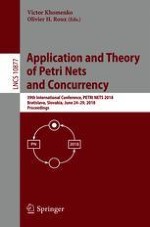This book constitutes the proceedings of the 39th International Conference on Application and Theory of Petri Nets and Concurrency, PETRI NETS 2018, held in Bratislava, Slovakia, in June 2018. Petri Nets 2017 is co-located with the 19th International Conference on Application of Concurrency to System Design, ACSD 2018.
The 15 regular and 8 tool papers, with 1 invited talk presented together in this volume were carefully reviewed and selected from 33 submissions. The focus of the conference is on following topics: Petri Nets Synthesis; Analysis and Model Checking; Languages; Semantics and Expressiveness; and Tools.
